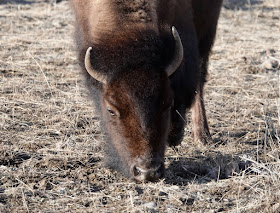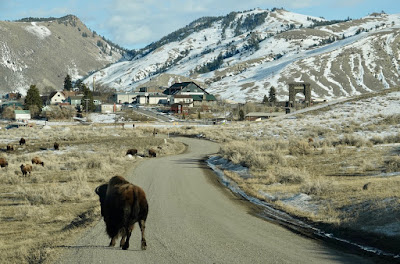Bison migrate from their higher elevation ranges such as Lamar Valley, where this photo was taken, as winter progresses and the snow becomes very deep or an ice layer forms. The bison can no longer get to the dried grass they need to survive their annual race between starvation and spring.
 |
After grazing, bison do what is called "loafing," resting on the ground while an incredibly efficient digestive system squeezes every bit of nutrition from the dried grass and new shoots they migrated to the Gardiner Basin in search of.
 |
Loafing in the Gardiner Basin must be more comfortable then loafing in the cold and snowy Lamar Valley--as the bison in this photo was doing earlier in the winter.
As spring nears, the Gardiner Basin's warm temperatures and snow-free range must be pleasant. I watched and laughed as this youngster romped among his matriarchal group, seemingly just for the joy of doing so.
But bison grazing, loafing, or romping near the Stephens Creek trap are at risk. This photo shows two of four mounted NPS staff. All are closing in on a group of bison grazing near the trap.
I watched with anger and sadness while the riders worked as a team to haze the bison toward the trap. After the bison disappeared into a gully, I could hear the whooping and hollering as the riders drove the bison into the trap.
The hazed herd will join all these other bison inside the trap. After blood testing and a short stay, a few will be moved to a quarantine facility--if space allows. But most of the captives will be hauled to a slaughter house. The hides and meat will be distributed to Native American tribes.
These bison, having made it past the trap, graze among glacial erratics, boulders deposited here more than 10,000 years ago as glaciers from the last Ice Age melted. Bison have endured numerous Ice Ages and avoided the die offs in which other large species such as mastodons, wooly mammoths, and camels vanished. Bison are incredible survivors.
The animal we call bison originated in southern Asia and began migrating northward 2-3 million years ago. Eventually they crossed the Bering Land Bridge and slowly followed their noses to the Great Plains. Some experts believe bison eventually fled to Yellowstone to escape the slaughter on the plains. Today the park contains our nation's last remaining continuously wild bison, and Montana laws confine them to Yellowstone. Of course, bison know nothing of laws and this male migrator, having avoided the trap, is now reaching the tree-lined park border.
I watched with concern as this migrator walked northward with resolve. The black and yellow sign just left of the bison's tail designates he is on US Forest Service property and no longer protected. The Beattie Gulch Trailhead sign behind him explains some rules of the bison hunt. He doesn't yet know that just one-quarter of a mile away shooters await.
These two bison were part of a group of two dozen or so grazing and walking in a protected area along Old Yellowstone Trail. In the background are shooters waiting for the bison to go where they can be shot. There were more than 20 vehicles crowding the roadside and at least 35 people watching and waiting.
Bison that migrate to and through the Gardiner Basin are shot or shipped to slaughter because they can carry brucellosis. Brucellosis transmitted to cattle can cause a cow to abort a calf and cut into ranchers' profits. But there has never been a transfer of brucellosis from wild bison to cattle. In fact, cattle transferred brucellosis to bison in the early years of the park. Still, ranchers' powerful lobby and the Montana Department of Livestock have branded bison a culprit that threatens their industry and way of life and must be treated as livestock and kept from grazing northward from Yellowstone.
Meanwhile, elk, like these along Old Yellowstone Trail, are treated as wildlife and can leave the park and go wherever they please. While doing so, elk have transferred brucellosis to cattle more than twenty times. Yet the Montana livestock industry has survived. I believe the industry would continue to survive even if bison were considered livestock and allowed to migrate freely and some transmitted brucellosis to cattle.

 |
| Signed Sets Available |



















This comment has been removed by a blog administrator.
ReplyDeleteAnother great job, Rick! Keep on keepin' on. . . .
ReplyDelete